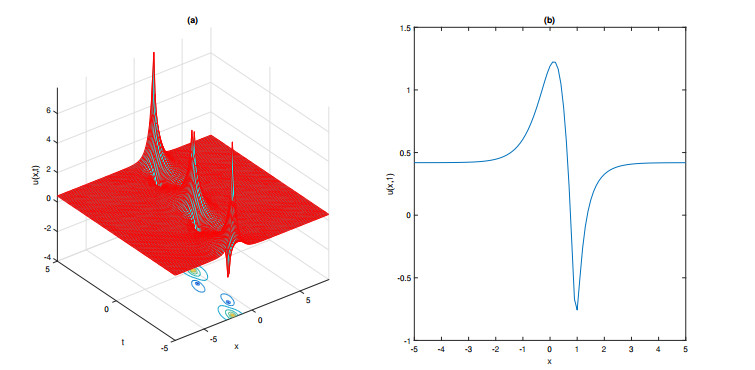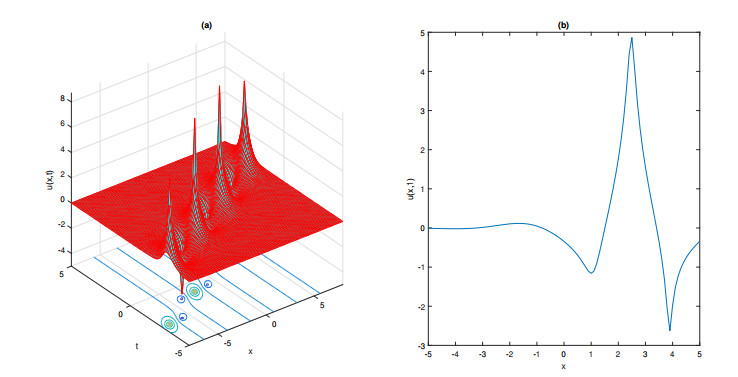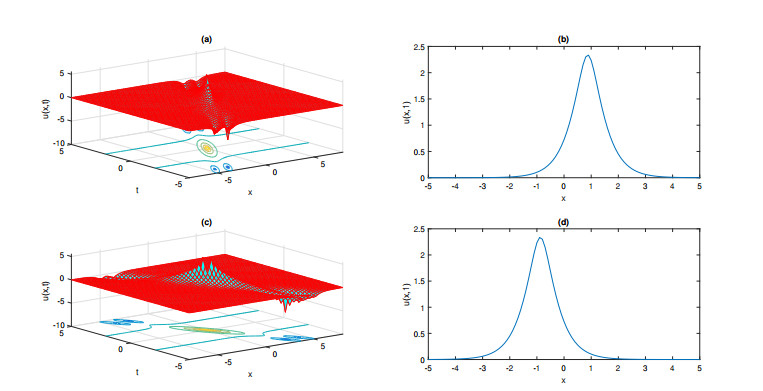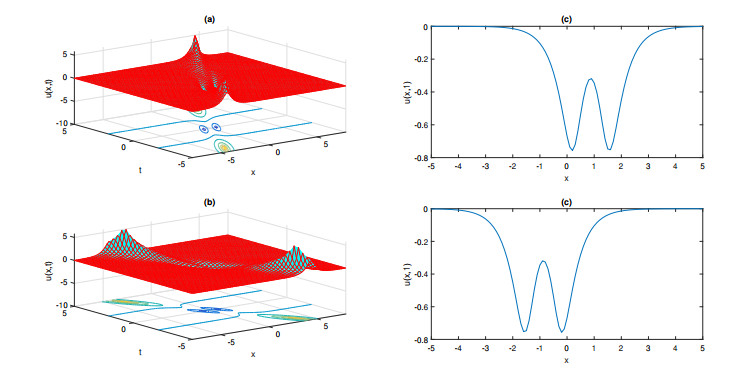Nonlinear equations personate a consequential role in scientific fields such as nonlinear optics, solid state physics and quantum field theory. This article studies the Tzitzéica-Dodd-Bullough-Mikhailov and Tzitzéica-type equations that appear in nonlinear optics. The Painlevé and traveling wave transformations both play a key role in revamping the aforementioned equations into nonlinear ordinary differential equations. Then, the simple ansatz approach is followed to seize complex singular, complex bright solitons and other kink type solutions. The existing literature unveils that this study is a novel contribution in the literature and the proposed approach is forthright and simple to implement for solving nonlinear problems. This approach has no extra condition as compared to many other techniques have. We also verify and interpret graphically the secured solutions through symbolic software Mathematica and MatLab respectively.
1.
Introduction
Evolution equations with nonlinear terms that appear in optics consist of the Tzitzéica-Dodd-Bullough-Mikhailov(TDBM), Tzitzéica-Dodd-Bullough(TDB), and the Liouville equations. The nonlinearities in the equations in this class include exponential functions. Look at the Tzitzéica-Dodd-Bullough-Mikhailov equation
firstly defined in Tzitzéica's study [1] in 1908. In the following years a variational form of the (1.1) was used in various studies as in [2,3]
named Tzitzéica-type (TT) equation. The conditions of the existence of polynomial conserved densities for the TDBM equation (1.1) in terms of derivatives of u were listed in [4]. Bäcklund transformation for the TDBM equation from the classification of Painleve-Gambier was given in details by Conte et al[5]. Zhu and Geng presented Darboux transformation for the 3×3-matrix spectral TDBM equation problem and derived some explicit solutions[6]. The inverse problem was solved and N-soliton solutions for the TDBM were found besides infinitely many conservation laws were defined for the Toda chain system equations in two dimensions [7]. One should note that Mikailov [7] claimed Conte et al.[5]'s suggestion on the polynomial conserved densities was not true. Some logarithmic and exponential function type solutions to the TDBM (1.1) were explicitly constructed by some Fourier series approach by El-Kalaawy [8]. The modification of the simple equation approach was also used to set the traveling wave solutions in terms of logarithmic functions with hyperbolic or trigonometric parameters to the TDBM (1.1) by employing two variable transformations to it [9]. Blow-up and broken singular traveling wave solutions covering periodic, solitary wave, kink and unbounded wave forms were successfully given with their plots for both the TDBM (1.1) and the TT (1.2) equations by integral bifurcation approach [2]. Soliton and periodic solutions were derived by the hyperbolic tangent method together with the Painleve property to both the TDBM (1.1) and the TT (1.2) equations[3]. For further study, this class of equations has been discussed in [10,11,13,14,15] by employing distinctive approaches. Recently, Alizamini et al. [16] investigated the Tzitzica type evolution equations by employing the new extended direct algebraic method.
Parallel developments in both computer technologies and symbolic softwares have greatly contributed to solve lots of problems defined in various fields covering applied mathematics, physics and many engineering fields. In the aforesaid fields, a diverse class of nonlinear fractional partial differential equations have successfully been managed via many effective methods [12,17,18,19,20,21,22,23,24,25,26,27]. Furthermore, some recent developments have been made on fractional differential equations via some recent definitions of fractional derivatives [28,29,30,31,32,34]. In particular, the Wick-type stochastic KdV equations have been discussed with a generalized type of conformable derivatives in white noise environment [35,36,38,39]. On the other hand, the soliton theory has become an important subject these days to study intensively in optical fibers and other areas of physical sciences [37,33,40,41,42,43,44,45,46]. Many researchers exercised both analytical and numerical approaches to investigate the nonlinear problems [47,48,49,50,51,52].
The organization of this article is as fallow. The story of simple ansatz approach is added in section 2. The aforesaid approach is employed to extract new complex soliton solutions of nonlinear Tzitzéica type equations in section 3. The results are discussed in section 4 and the conclusion is drawn in the last section.
2.
A simple ansatz approach
The present section produces a succinct description of the simple ansatz approach [53]. For this aim, suppose that a nonlinear PDE can be read as
The classical wave transform given below
for non-zero constants k,l that work as amplitude and speed of the wave respectively, can be modified the PDE (2.1) into the following ODE
Then, we guess the solution of the form given by,
where, α0,α1,α2,...,αN are constant parameters and N is positive natural number that will be found by the principle of homogeneous balance. ψ(μ) is consciously chosen to be csch(μ) and sech(μ) to determine hyperbolic type solution while sec(μ) and csc(μ) are periodic solutions, respectively.
2.1. Solutions for the TDBM equation
The DTDBM equation is read as
and using Painlevé transform v=eu or u=ln(v), the Eq (2.4) reduces to:
Eq (2.5) is mutated to the following ODE by employing v(x,t)=V(μ), μ=kx+lt:
The balance between the terms VV″ with V3 implies N=2.
By inserting Eq (2.7) with its derivatives in Eq (2.6) and setting each coefficient of powers of csch(μ) to zero, one obtains a nonlinear system of algebraic equations.
The solution of this system gives
The following hyperbolic function solutions are extracted.
For more hyperbolic function solution, we take ψ(μ)=sech(μ)
By inserting Eq (2.9) into Eq (2.6), and gather the terms with the same powers of sech(μ).\\ Then, by putting each coefficient of sech(μ) equal to zero, we get a set of nonlinear algebraic equations. On solving, we secure the following set of solutions:
Thus, substitution of the above values into the Eq (2.4), the solutions are set as follows:
Here the three types of graphs including 3D graph, contour graph and 2D graph, are displayed in Figures 1 and 2 for selected solutions.
2.2. Periodic solutions for the TDBM equation
For periodic solutions, we commence with:
Setting coefficients of power of sec(μ) to zero yields an algebraic system of equations. Thus, the solution gives
the following trigonometric function solutions
For more periodic solutions, we take the following non-trivial solution:
Inserting Eq (2.13) and its derivatives into Eq (2.6) gives
Thus the following trigonometric function solutions are obtained.
2.3. Solutions for the TT equation
The TT equation is read as
using the Painlevé transformation v=eu or u=ln(v), the Eq (2.14) reduces to
Let us introduce a transformation v(x,t)=V(μ), μ=kx+lt, Eq (2.15) can be turned into an ODE:
Through balancing principle, we get N=2, then the non-trivial solution can be read as
by inserting Eq (2.17) into Eq (2.16), and rearranging the terms with the same power of csch(μ) together.
Then, putting each coefficient of csch(μ) equal to zero, we obtain a set of nonlinear algebraic equations. On solving, we find the following set of solutions.
Thus, by substituting the above values into Eq (2.17), the following new exact solutions can be written as
For more hyperbolic function solution, we take the non trivial solution as
Substituting Eq (2.21) into Eq (2.16), and reposition the terms with the same power of sech(μ) together.
Then, by putting each coefficient of sech(μ) equal to zero, we approach to a set of nonlinear algebraic equations. On solving, we find the following set of solutions.
Thus, by replacing the above values into Eq (2.21), the new exact solutions can be written as follows:
Here the three types of graphs including 3D graph, contour graph and 2D graph, are displayed in Figures 3 and 4 for different solutions.
2.4. Periodic solutions for TT equation
We commence with the following solution for Eq (2.14).
Substituting Eq (2.23) into Eq (2.16), and compile all terms with the same power of sec(μ) together.
Then, by setting each coefficient of sec(μ) equal to zero, we obtain a set of nonlinear algebraic equations. On solving, we find the following set of solutions:
Thus, by substituting the above values into the Eq (2.23), the new periodic solutions can be derived as follows:
Again for periodic solutions in terms of csc(μ), we have
Substituting Eq (2.24) into Eq (2.16), and reposition the terms with the same power of csc(μ) together.
Then, by setting each coefficient of csc(μ) equal to zero, we obtain a set of nonlinear algebraic equations. On solving, we procure the following set of solutions:
Thus, by substituting the above values into the Eq (2.24), the new periodic solutions can be written as follows:
3.
Results and discussions
Hosseini and his coworkers [13] used a novel exponential method to study the nonlinear Tzitzéica-type equations and obtained the exact solutions for the aforesaid equations. Moreover the same authors [14] worked for similar equations via the expa function method to obtain exact solutions in the rational form. Recently, Alizamini et al. [16] presented a new method for attaining solitary wave solutions of the aforementioned equation. Almost all the articles discussed these equations in different ways than that of our discussion. We have adopted a novel simplest technique for the first time to explore the above-mentioned equations. This scheme produced bright, singular and kink type soliton solutions successfully. Most importantly, one can obtain the dark soliton solutions from Eq (2.3) by replacing the value of ψ(μ) by tanh(μ). Similarly, Eq (2.3) can produce singular solitons and other solutions. Thus, the analytical and graphical outcomes ratify that the proposed approach is more efficient and provide a direct way of finding novel solutions.
4.
Conclusions
The basic goal of this work has been achieved via the novel simple ansatz method with the Painlevé transformations. The scientifically important Tzitzéica type nonlinear equations have been explored for their abundant exact solitons and trigonometric function solutions. In particular, the TDBM and the TT equations are figured out for complex bright, complex singular and kink type soliton solutions through symbolic soft computation in Mathematica. Also, the numerical simulations of some secured solutions have been demonstrated to analyze the dynamical behavior of the waves. Furthermore, these solutions might have significant importance in science and engineering fields. The study also shows that the method is transparent and handy to implement. Thus we conclude that one can implement the aforesaid approach to other nonlinear differential equations.
Acknowledgments
All the authors are thankful to their respective institutes. The research work of first author was supported by the National Key R & D Program of China (No. 2018YFB1005104) and the Guangzhou Academician and Expert Workstation (No. 20200115-9).
The research work of second author was supported by ORIC, CUI, Pakistan, under project NO: 16-85/CRGP/CIIT/VEH/1141.
Conflict of interest
The authors declare that there are no conflicts of interest.










 DownLoad:
DownLoad:






